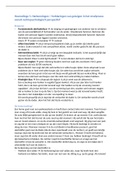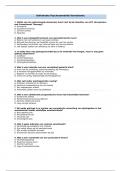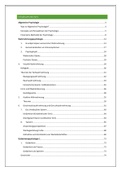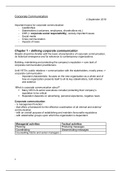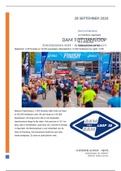ESCOM
PD3 011
Crystal structures of HIV-1 protease-inhibitor complexes
Krzysztof Appelt
Agouron Pharmaceuticals Inc., 3565 General Atomics Court, San Diego, CA 92121, U.S.A.
Received 22 March 1993
Accepted 15 June 1993
Key words: HIV protease; Protease inhibitors; X-ray structure; Active site-inhibitor interaction
SUMMARY
HIV PR is one of the most popular targets for the developmentof drugs for treatment of AIDS and in the
last few years, a significanteffort has been directed towards its structure elucidation in both liganded and
unliganded form. In this review, 25 available crystal structures of HIV PR complexes with inhibitors are
described. Binding of peptidic inhibitors to the HIV PR active site are analyzed in view of the formation of
potential hydrogen bonds and fillingof hydrophobic space. A potential impact of the accumulated crystallo-
graphic effort on the development of computational methods for structure-based drug design is briefly
addressed.
INTRODUCTION
Since the discovery of human immunodeficiency virus (HIV) as the causative agent of acquired
immunodeficiency syndrome (AIDS), perhaps the largest and most powerful consortium of scien-
tists ever assembled to tackle a single disease has been brought to bear on the problem of AIDS
and its treatment. From an unprecedented wealth of information regarding the molecular biology
and virology of HIV collected in recent years, it became possible to identify numerous interven-
tion points in the viral life cycle that could be exploited in the development of drugs for AIDS
therapy (for reviews see [1,2]). Among these, the virally-encoded protease has emerged as one of
the most popular targets, and the rationale for this may be summarized as follows:
- The processing of the gag and gag-pol polyproteins by HIV protease (HIV PR) is essential for
viral replication. Inactivation of HIV PR, by either chemical inhibition or mutation, leads to the
production of immature, noninfectious viral particles [3,4].
- Based on the presence of the single signature sequence aspartic acid-threonine-glycine, as well
as some weak homology with the eukaryotic aspartic proteases such as pepsins, it was suggested
that the HIV PR and other retroviral proteases might belong to the same family [5]. The family
of aspartyl proteases has been intensely studied in the past, and knowledge gained from studies
of these enzymes has allowed early inferences as to the structure and function of the dimeric HIV
PR. Moreover, the intensive effort over the past two decades to make inhibitors of human renin,
0928-2866/$10.00 © 1993 ESCOM Science Publishers B.V.
,24
a member of the family of aspartic proteases, has provided great impetus to design inhibitors of
HIV PR. In fact, some of these renin inhibitors have turned out to be effective inhibitors of HIV
PR as well, and have served as the starting point for drug design.
- The small size ofHIV PR, and the ease of its production, both by recombinant DNA methods
[6,7] and total chemical synthesis [8], have facilitated a wide-ranging attack aimed at the elucida-
tion of its structure and enzymology. In a few years time HIV PR has become one of the best
characterized enzymes.
The level of involvement of protein crystallography in the elucidation of structures of HIV PR
and its complexes with various inhibitors is unprecedented in the history of the field, with more
than 170 structures having been solved in 19 laboratories [9]. Most of these structures have been
solved in laboratories affiliated with pharmaceutical companies and, at present, are not readily
available. However, a number of them have already been published [10-22], and atomic coordi-
nates of other structures are becoming available by direct distribution from the originating
laboratories. This review will discuss the current state of structural investigations of HIV PR
inhibitor complexes based on available data, as well as several unpublished structures solved in
my laboratory. The first part of this review will concentrate on the structure of the protein and
changes caused by inhibitor binding. Also, the question of the symmetry of the HIV PR dimer
and its crystallographic manifestation will be briefly addressed. The second part will discuss the
different classes of inhibitors and their interaction with the protease active site. Finally, in the last
part, the potential impact of such an unprecedented crystallographic effort in the area of structure
elucidation of HIV PR inhibitor complexes on the development of methods for computer-aided
drug design will be discussed.
STRUCTURE OF THE APO-FORM OF HIV PR
HIV PR and other retroviral proteases were tentatively assigned to the aspartic proteinase
family on the basis of putative active-site sequence homology [5], but are, nevertheless, only about
one-third the size of the two-domain, eukaryotic enzymes. For this reason, the retroviral proteas-
es were hypothesized to function as dimers in which each monomer would contribute one of the
two conserved aspartates to the active site [23]. This hypothesis was verified by the crystal-
structure determinations of Rous sarcoma virus protease [24], recombinant [25,26] and chemical-
ly synthesized [27] HIV PR. The existence of retroviral dimeric aspartic proteases has validated
the observation of Tang et al. [28] who, based on the sequence and structure analysis of eukaryo-
tic pepsins, predicted that this family of enzymes evolved from an ancestral homodimeric pro-
tease, as a result of gene duplication. Considering the molecular biology and the life cycle of
retroviruses, the presence of a homodimeric aspartic protease is not surprising. As pointed out by
Meek et al. [29], it makes sense that the retroviruses are parsimonious in their genetic information
and that, if they encode a proteolytic enzyme, it should be as small as possible. In addition, a more
fundamental property may be that an obligate dimeric protease provides a regulatory mechanism
to control activation of the enzyme.
The three-dimensional structure of HIV PR apo-form is shown in Fig. 1. In all published
investigations, the crystals were isomorphous and belonged to space group P41212 with one
monomer in the crystallographic asymmetric unit [25-27]. Thus, the two monomers in the dimeric
structure of HIV PR apo-form are crystaltographically identical. The general topology of the
, 25
Fig. 1. Ribbon representation of the structure of the H I ¥ PR apo-enzyme.
HIV PR monomer is similar to that of a single domain in pepsin-like aspartic proteases, with two
similar motifs related by an approximate intramolecular two-fold axis. Adopting the strand
nomenclature suggested for endothiapepsins [30], each motif contains antiparallel strands a, b, c
Fig. 2. Ribbon representation of the structure of HIV PR complexed with pepstatin A.

